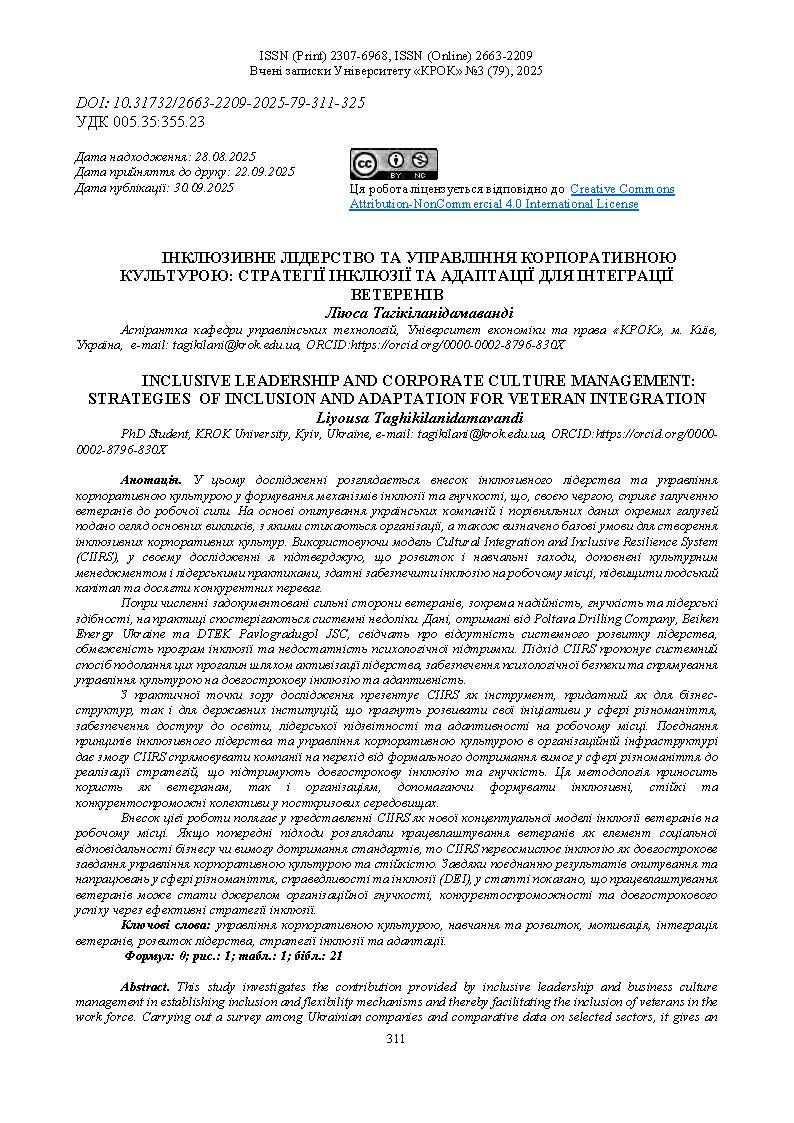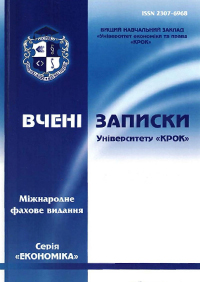ІНКЛЮЗИВНЕ ЛІДЕРСТВО ТА УПРАВЛІННЯ КОРПОРАТИВНОЮ КУЛЬТУРОЮ: СТРАТЕГІЇ ІНКЛЮЗІЇ ТА АДАПТАЦІЇ ДЛЯ ІНТЕГРАЦІЇ ВЕТЕРАНІВ
DOI:
https://doi.org/10.31732/2663-2209-2025-79-311-326Ключові слова:
управління корпоративною культурою, навчання та розвиток, мотивація, інтеграція ветеранів, розвиток лідерства, стратегії інклюзії та адаптаціїАнотація
У цьому дослідженні розглядається внесок інклюзивного лідерства та управління корпоративною культурою у формування механізмів інклюзії та гнучкості, що, своєю чергою, сприяє залученню ветеранів до робочої сили. На основі опитування українських компаній і порівняльних даних окремих галузей подано огляд основних викликів, з якими стикаються організації, а також визначено базові умови для створення інклюзивних корпоративних культур. Використовуючи модель Cultural Integration and Inclusive Resilience System (CIIRS), у своєму дослідженні я підтверджую, що розвиток і навчальні заходи, доповнені культурним менеджментом і лідерськими практиками, здатні забезпечити інклюзію на робочому місці, підвищити людський капітал та досягти конкурентних переваг.
Попри численні задокументовані сильні сторони ветеранів, зокрема надійність, гнучкість та лідерські здібності, на практиці спостерігаються системні недоліки. Дані, отримані від Poltava Drilling Company, Beiken Energy Ukraine та DTEK Pavlogradugol JSC, свідчать про відсутність системного розвитку лідерства, обмеженість програм інклюзії та недостатність психологічної підтримки. Підхід CIIRS пропонує системний спосіб подолання цих прогалин шляхом активізації лідерства, забезпечення психологічної безпеки та спрямування управління культурою на довгострокову інклюзію та адаптивність.
З практичної точки зору дослідження презентує CIIRS як інструмент, придатний як для бізнес-структур, так і для державних інституцій, що прагнуть розвивати свої ініціативи у сфері різноманіття, забезпечення доступу до освіти, лідерської підзвітності та адаптивності на робочому місці. Поєднання принципів інклюзивного лідерства та управління корпоративною культурою в організаційній інфраструктурі дає змогу CIIRS спрямовувати компанії на перехід від формального дотримання вимог у сфері різноманіття до реалізації стратегій, що підтримують довгострокову інклюзію та гнучкість. Ця методологія приносить користь як ветеранам, так і організаціям, допомагаючи формувати інклюзивні, стійкі та конкурентоспроможні колективи у посткризових середовищах.
Внесок цієї роботи полягає у представленні CIIRS як нової концептуальної моделі інклюзії ветеранів на робочому місці. Якщо попередні підходи розглядали працевлаштування ветеранів як елемент соціальної відповідальності бізнесу чи вимогу дотримання стандартів, то CIIRS переосмислює інклюзію як довгострокове завдання управління корпоративною культурою та стійкістю. Завдяки поєднанню результатів опитування та напрацювань у сфері різноманіття, справедливості та інклюзії (DEI), у статті показано, що працевлаштування ветеранів може стати джерелом організаційної гнучкості, конкурентоспроможності та довгострокового успіху через ефективні стратегії інклюзії.
Завантаження
Посилання
Armstrong, N., & McDonough, J. (2014). Revisiting the business case for hiring a veteran: A strategy for cultivating competitive advantage. Institute for Veterans and Military Families, Syracuse University. Available at: https://ivmf.syracuse.edu/wp-content/uploads/2019/10/Revisiting-Business-Case-for-Hiring-a-Veteran-Full-Report.pdf
Carmeli, A., Reiter-Palmon, R., & Ziv, E. (2021). Inclusive leadership and employee involvement in creative work: The mediating role of psychological safety. Psychology of Aesthetics, Creativity, and the Arts, 15(1), 135–146. https://doi.org/10.1037/aca0000337
Gibbs, W. C., Ortosky, L., MacLean, A., & Sherman, D. K. (2025). Structure in transition: The role of structure in facilitating workplace efficacy and belonging for military veterans and civilians. PLoS ONE, 20(2), e0317575. https://doi.org/10.1371/journal.pone.0317575
Gonzalez, J. A., & Simpson, J. (2021). The workplace integration of veterans: Diversity and fit perspectives. Human Resource Management Review, 31(2), Article 100775. https://doi.org/10.1016/j.hrmr.2020.100775
Harrod, M., Miller, E. M., Henry, J., & Zivin, K. (2023). Veterans in the workplace: Keys to successful transition. Journal of Veterans Studies, 9(1), 1–12. Retrieved from https://pmc.ncbi.nlm.nih.gov/articles/PMC10013406
Kendrick, I. J. (2025). The first salute: Why ethical onboarding matters for veteran hires. Journal of Veterans Studies, 11(1), 213–217. https://doi.org/10.21061/jvs.v11i1.744
McKinsey & Company. (2023). The value of integrating veterans into the workforce. Report. Retrieved from https://www.mckinsey.com/featured-insights/themes/the-value-of-integrating-veterans-into-the-workforce
Optus. (2023). How Optus is strengthening its workforce with ex-service people. The Australian (sponsored content). Available at: https://www.theaustralian.com.au/business/sponsored-content/how-optus-is-strengthening-its-workforce-with-exservice-people/news-story/ffaf462799c8ecefa6cb2eb1886147c7
People Managing People. (2024). Inclusive leadership: 3 practical frameworks to inspire inclusive leaders. Blog post. https://peoplemanagingpeople.com/personal-development/leadership-management/inclusive-leadership
Prime, J., & Salib, E. R. (2014). Inclusive leadership: The view from six countries. Catalyst report. Retrieved from https://www.catalyst.org/research/inclusive-leadership-the-view-from-six-countries
Randel, A. E., Galvin, B. M., Shore, L. M., Ehrhart, K. H., Chung, B. G., Dean, M. A., & Kedharnath, U. (2018). Inclusive leadership: Realizing positive outcomes through belongingness and uniqueness. Human Resource Management Review, 28(2), 190–203. https://doi.org/10.1016/j.hrmr.2017.07.002
Syracuse University Institute for Veterans and Military Families. (2016). Work after service: Developing workforce readiness and veteran talent for the future. Policy report. Retrieved from https://ivmf.syracuse.edu/wp-content/uploads/2016/05/WORK-AFTER-SERVICE-Developing-Workforce-Readiness-and-Veteran-Talent-for-the-Future.pdf
The Diversity Movement. (2024). 7 high-impact inclusive leadership practices you can adopt today. Blog article. https://thediversitymovement.com/7-high-impact-inclusive-leadership-practices-adopt-today
Veterans Employment Program. (n.d.). Case studies. Government website. https://www.veteransemployment.gov.au/campaign-and-media/case-studies
Wang, H., Demerouti, E., & Le Blanc, P. (2017). Transformational leadership, adaptability, and job crafting: The moderating role of organizational identification. Journal of Vocational Behavior, 100, 185–195. https://doi.org/10.1016/j.jvb.2017.03.009
Williams, T. A., Gruber, D. A., Sutcliffe, K. M., Shepherd, D. A., & Zhao, E. Y. (2017). Organizational response to adversity: Fusing crisis management and resilience research streams. Academy of Management Annals, 11(2), 733–769. https://doi.org/10.5465/annals.2015.0134
Lengnick-Hall, C. A., Beck, T. E., & Lengnick-Hall, M. L. (2011). Developing a capacity for organizational resilience through strategic human resource management. Human Resource Management Review, 21(3), 243–255. https://doi.org/10.1016/j.hrmr.2010.07.001
Edmondson, A. C., & Lei, Z. (2014). Psychological safety: The history, renaissance, and future of an interpersonal construct. Annual Review of Organizational Psychology and Organizational Behavior, 1, 23–43. https://doi.org/10.1146/annurev-orgpsych-031413-091305
Shore, L. M., Cleveland, J. N., & Sanchez, D. (2018). Inclusive workplaces: A review and model. Human Resource Management Review, 28(2), 176–189. https://doi.org/10.1016/j.hrmr.2017.07.003
Kotter, J. P. (1996). Leading change. Harvard Business School Press.
Armenakis, A. A., & Harris, S. G. (2009). Reflections: Our journey in organizational change research and practice. Journal of Change Management, 9(2), 127–142. https://doi.org/10.1080/14697010902879079

Downloads
Опубліковано
Як цитувати
Номер
Розділ
Ліцензія

Ця робота ліцензується відповідно до Creative Commons Attribution-NonCommercial 4.0 International License.

